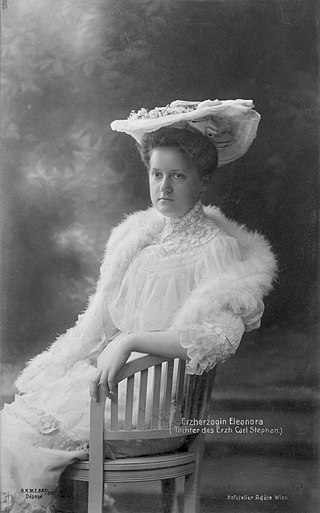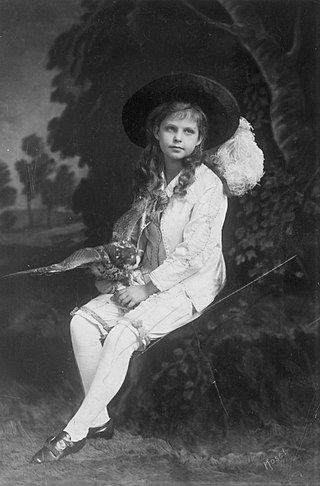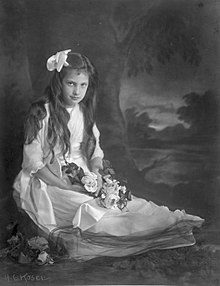Early life
Archduchess Assunta of Austria was born on 10 August 1902 in Vienna, Austria. [1] She was the eighth of ten children of Archduke Leopold Salvator of Austria (1863–1931) and his wife Infanta Blanca of Spain (1868–1949). She was given the baptismal names Assunta Alice Ferdinandine Blanca Leopoldina Margarethe Beatrix Raphaela Michaela Philomena. [2]
Archduchess Assunta grew up in the last period of the Habsburg monarchy. She was raised with her many brothers and sisters in the various properties owned by her parents enjoying a comfortable and privileged life. Their main residence was the Palais Toskana in the district of Wieden in Viena with Schloss Wilhelminenberg, on the Eastern slopes of the Gallitzinberg, in the Wienerwald Western parts of the Austrian capital as their country estate. Vacations were spent near Viareggio, Italy where Infanta Blanca owned, la Tenuta Reale, a rural property. Theirs was a multicultural household as Assunta's paternal ancestors had reigned in Austria, Tuscany and the Kingdom of the Two Sicilies. Her maternal family had reigned in Spain, Parma, Modena, Portugal and France. The youngest of five sisters, Archduchess Assunta was raised paired with her sister Archduchess Maria Antonia.
Exile
Archduchess Assunta was sixteen years old at the fall of Habsburg monarchy following the end of World War I, which marked a sharpdown turn in her family's prosperity. The republican government of Austria confiscated the properties of the Habsburgs, and the family lost their entire fortune. [3] Assunta's eldest brothers, Archdukes Rainer and Leopold, remained in Austria and recognized the new republic, while the rest of the family moved to Spain in January 1919. [2] They settled in Barcelona, living with simplicity as they had limited means. Assunta's three elder sisters, Archduchesses Dolores, Inmaculata and Margaretha, were pliable; Archduchesses Assunta and Maria Antonia were more rebellious and clashed often with their mother Infanta Blanca.
While living in Barcelona, Assunta, following in the footsteps of her sister, Maria Antonia, turned increasingly towards religion. [4] Although their parents were observant Catholics, they found their youngest daughter's religious fervor worrisome. Archduchess Maria Antonia abandoned her desire to become a nun and married an impoverished Majorcan aristocrat, but Assunta remained adamant in her determination to become a nun. [5] After running away on a ship to South America, Assumpta, still a minor, was returned to her parents who relented their opposition. [6] With their permission, she eventually entered the convent of Santa Teresa de Tortosa near Barcelona. [7] At the outbreak of the Spanish Civil War, the convent was attacked and the nuns were forced to flee for their lives. Those like Assunta, who had not yet taken their final vows, were free to follow a secular life. Assunta obtained permission to leave her order and joined her mother and unmarried siblings who were then living in Viareggio. [8] In the late 1930s, through one of her brothers, Archduchess Assunta met Joseph Hopfinger (1905-1992), a Jewish Polish doctor. [9] Against her mother's opposition, they married in September 1939 at Ouchy, Switzerland. Shortly after, her husband was called to service in the army until the fall of France when he was demobilized. [10] They were reunited in London and moved to Barcelona where their eldest daughter, Teresa, was born in December 1940. [11]
Later life
The German persecution of the Jews compelled Assunta, her husband, and their infant daughter to leave Europe. Both of her husband's parents were killed by the Russians, as their property was within the mineral-rich region of modern-day Lviv, Ukraine. As her husband was Jewish, they decided to emigrate to the United States with the help of Assunta's brothers Leopold and Franz Joseph, who were living in America and paid for their trip to New York. [12] Assunta's husband worked as a doctor, and a second daughter was born in New York City in 1942. [13]
Archduchess Assunta had two daughters from her marriage to Joseph Hopfinger:
- Maria Teresa Hopfinger b. 5 Dec 1940 ∞ (1961-1967) Edward Joseph Hetsko, Jr ∞ (1969-1970) Anatole Ferlet. She had two children.
- Juliet Elisabeth Maria Assunta Hopfinger b. 30 Oct 1942. Married five times. She had three children.
However, the marriage was not a success. [14] Having married a European princess, Assunta's husband had hoped to inherit a fortune from his wife. As this never materialized, he became disenchanted with the marriage. The couple separated after the war, divorcing on 25 July 1950. [14]
Archduchess Assunta moved with her daughters to San Antonio, Texas, where she lived for the rest of her life. She remained very attached to the Catholic Church and held a variety of jobs to support herself and her two young children, including for some time working as a claim clerk. [14] Late in her life, she made one trip to Europe to visit her surviving siblings. She died on 24 January 1993 at age 90 in San Antonio, Texas. [14]

Zita of Bourbon-Parma was the wife of Charles I, the last monarch of Austria-Hungary. As such, she was the last Empress of Austria and Queen of Hungary, in addition to other titles. She was declared Servant of God by Pope Benedict XVI.

Margaret Theresa of Spain was, by marriage to Leopold I, Holy Roman Empress, German Queen, Archduchess of Austria and Queen of Hungary and Bohemia. She was the daughter of King Philip IV of Spain and the elder full-sister of Charles II, the last of the Spanish Habsburgs. She is the central figure in the famous Las Meninas by Diego Velázquez, and the subject of many of his later paintings.

Maria Anna of Spain was a Holy Roman Empress and Queen of Hungary and Bohemia by her marriage to Ferdinand III, Holy Roman Emperor. She acted as regent on several occasions during the absences of her husband, notably during his absence in Bohemia in 1645.

Archduke Leopold Maria of Austria, Prince of Tuscany was the second son of Archduke Leopold Salvator, Prince of Tuscany and Infanta Blanca of Spain. At the fall of Habsburg monarchy he remained in Austria and recognized the new republic in order to marry Dagmar, Baroness von Nicolics-Podrinska. The couple had one daughter. After divorcing his wife in 1931, Leopold eventually emigrated to the United States where he became a naturalized American citizen under the name Leopold Lorraine, and where he remarried. He died in 1958 in Connecticut.

Archduke Anton of Austria, Prince of Tuscany was a possible Carlist-Carloctavismo pretender to the Spanish throne and an Archduke of Austria by birth. In 1919, all titles of nobility and royalty were prohibited and outlawed in Austria. He was the seventh of ten children born to Archduke Leopold Salvator of Austria, Prince of Tuscany and Infanta Blanca of Spain, daughter of Infante Carlos, Duke of Madrid.

Archduke Karl Pius of Austria, Prince Royal of Hungary and Bohemia, Prince of Tuscany, known as Carlos Pío de Habsburgo-Lorena y de Borbón in Spanish, was a member of the Tuscan branch of the Imperial House of Habsburg and a Carlist claimant to the throne of Spain under the assumed name of "Carlos VIII". He was the tenth and youngest child of Archduke Leopold Salvator of Austria, Prince of Tuscany and Infanta Blanca of Spain.

Claudia Felicitas of Austria was by birth an Archduchess of Austria and by marriage Holy Roman Empress, German Queen, Archduchess consort of Austria, Queen consort of Hungary and Bohemia as the second wife of Leopold I.

Princess Maria Immaculata of Bourbon-Two Sicilies was fifth child and second-eldest daughter of Ferdinand II of the Two Sicilies and his wife Maria Theresa of Austria. Through her marriage to Archduke Karl Salvator of Austria, Maria Immaculata became an Austrian Archduchess.

Archduke Leopold Salvator, Prince of Tuscany, was the son of Archduke Karl Salvator of Austria and Princess Maria Immaculata of Bourbon-Two Sicilies.

Infanta Blanca of Spain was the eldest child of Carlos, Duke of Madrid, Carlist claimant to the throne of Spain and his wife Princess Margherita of Bourbon-Parma. Blanca was a member of the House of Bourbon and - according to the Carlists - an Infanta of Spain by birth. In 1889 she married Archduke Leopold Salvator of Austria. The couple had ten children. The family left Austria after the end of the Monarchy and finally settled in Barcelona. When the male line of Blanca's family died out at the death of her uncle, Alfonso Carlos, Duke of San Jaime, some of the Carlists recognized her as the legitimate heiress to the Spanish throne.
Maria Antonia is a feminine Portuguese given name from the root names Miriam and Antonius. Notable people referred to by this name include the following:

Archduchess Mechthildis of Austria was a daughter of Archduke Charles Stephen of Austria and a first cousin of King Alphonso XIII of Spain. She was a member of the Teschen branch of the House of Habsburg-Lorraine and an Archduchess of Austria and Princess of Hungary, and Bohemia by birth. In 1913 she married Prince Olgierd Czartoryski. The couple had four children and lived in Poland until the outbreak of World War II when they emigrated to Brazil.

Archduchess Eleonora of Austria was a daughter of Archduke Charles Stephen of Austria and a first cousin of King Alphonso XIII of Spain. She was member of the Teschen branch of the House of Habsburg-Lorraine and an Archduchess of Austria and Princess of Bohemia, Hungary, and Tuscany by birth. She renounced to her titles upon her morganatic marriage to Alfons Kloss, the captain of her father's yacht. During World War II her sons served in the German army.

Archduke Rainer of Austria was a member of the House of Habsburg-Lorraine, a member of the Tuscan branch of the Imperial House of Habsburg, an Archduke of Austria and Prince of Tuscany by birth. He was the eldest son Archduke Leopold Salvator of Austria, Prince of Tuscany. He served as officer in the Austrian army during World War I. At the fall of the Habsburg dynasty, he remained in Vienna and worked for a time as taxi driver. He died unmarried at the age of 34 from blood-poisoning.

Archduchess Dolores of Austria German: Dolores Erzherzogin von Österreich-Toskana;(5 May 1891 – 10 April 1974) was a daughter of Archduke Leopold Salvator of Austria. She was member of the Tuscan branch of the Imperial House of Habsburg-Lorraine, an Archduchess of Austria and Princess of Tuscany by birth. After the dissolution of Austria-Hungary, she lived under reduced circumstances with her family in Spain, Austria, and Italy. She died unmarried.

Archduchess Immaculata of Austria German: Inmmaculata, Erzherzogin von Österreich-Toskana;(9 September 1892 – 3 September 1971) was a daughter of Archduke Leopold Salvator of Austria. She was member of the Tuscan branch of the Imperial House of Habsburg-Lorraine, an Archduchess of Austria and Princess of Tuscany by birth. After the dissolution of Austria-Hungary, she lived in exile, first in Barcelona and from the 1930s until the end of her life in Italy. In 1932, she married an Italian aristocrat, Igino Neri-Serneri. The couple remained childless.

Archduchess Margaretha of Austria (German: Margaretha, Erzherzogin von Österreich-Toskana; was a daughter of Archduke Leopold Salvator of Austria and Infanta Blanca of Spain. She was member of the Tuscan branch of the Imperial House of Habsburg-Lorraine, an Archduchess of Austria and Princess of Tuscany by birth. After the dissolution of Austria-Hungary, she lived in exile, first in Barcelona and from the 1930s until the end of her life in Italy. In 1937, she married an Italian diplomat, Marchese Francesco Maria Taliani de Marchio. The couple, who had married in their forties, did not have children.

Archduchess Maria Antonia of Austria German: Maria Antonia, Erzherzogin von Österreich-Toskana was a daughter of Archduke Leopold Salvator of Austria and Infanta Blanca of Spain. She was member of the Tuscan branch of the Imperial House of Habsburg-Lorraine, an Archduchess of Austria and Princess of Tuscany by birth. In 1919, after the dissolution of Austria-Hungary, she moved with her family to Spain. In 1924 she married Ramón de Orlandis y Villalonga, a Spanish aristocrat. When she became a widow during the Spanish Civil War, Archduchess Maria Antonia moved permanently to South America where she remarried.

Archduke Franz Josef of Austria–Tuscany was the fourth son of Archduke Leopold Salvator of Austria, Prince of Tuscany and Infanta Blanca of Spain. At the fall of Habsburg monarchy he moved to Barcelona, where he became a naturalized Spanish citizen. He married morganatically twice and had a daughter from his second marriage. During World War II he lived in the United States, working in the forestry industry. In 1955 he returned to Austria. He inherited the Carlist pretensions to the Spanish throne of his brother Archduke Karl Pius and called himself Duke of Madrid. He died in 1975.

Archduchess Maria Karoline of Austria was an Archduchess of Austria. She may have been named after her great aunt Maria Carolina.


















